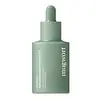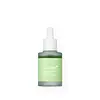What's inside
What's inside
 Key Ingredients
Key Ingredients

 Benefits
Benefits

 Concerns
Concerns

No concerns
 Ingredients Side-by-side
Ingredients Side-by-side

Artemisia Capillaris Extract
Water
Skin ConditioningMethylpropanediol
SolventNiacinamide
SmoothingMethyl Gluceth-20
HumectantCentella Asiatica Extract
CleansingMelaleuca Alternifolia Leaf Extract
PerfumingHouttuynia Cordata Extract
Skin ConditioningTheobroma Cacao Seed Extract
AntioxidantCinnamomum Zeylanicum Bark Extract
AntimicrobialCitrus Aurantium Bergamia Fruit Oil
MaskingGlycerin
HumectantOctyldodeceth-16
EmulsifyingPanthenol
Skin ConditioningTromethamine
BufferingCarbomer
Emulsion StabilisingSalicylic Acid
MaskingBetaine Salicylate
AntimicrobialXanthan Gum
EmulsifyingAdenosine
Skin ConditioningDisodium EDTA
Sodium Polyacrylate
AbsorbentPvm/Ma Copolymer
Emulsion StabilisingGluconolactone
Skin ConditioningDextrin
AbsorbentCitric Acid
BufferingCapryloyl Salicylic Acid
ExfoliatingCapryloyl Glycine
CleansingHexylene Glycol
EmulsifyingSarcosine
Skin Conditioning1,2-Hexanediol
Skin ConditioningEthylhexylglycerin
Skin ConditioningLimonene
PerfumingLinalool
PerfumingArtemisia Capillaris Extract, Water, Methylpropanediol, Niacinamide, Methyl Gluceth-20, Centella Asiatica Extract, Melaleuca Alternifolia Leaf Extract, Houttuynia Cordata Extract, Theobroma Cacao Seed Extract, Cinnamomum Zeylanicum Bark Extract, Citrus Aurantium Bergamia Fruit Oil, Glycerin, Octyldodeceth-16, Panthenol, Tromethamine, Carbomer, Salicylic Acid, Betaine Salicylate, Xanthan Gum, Adenosine, Disodium EDTA, Sodium Polyacrylate, Pvm/Ma Copolymer, Gluconolactone, Dextrin, Citric Acid, Capryloyl Salicylic Acid, Capryloyl Glycine, Hexylene Glycol, Sarcosine, 1,2-Hexanediol, Ethylhexylglycerin, Limonene, Linalool
Centella Asiatica Leaf Water
Skin ConditioningWater
Skin ConditioningGlycerin
HumectantButylene Glycol
HumectantMethylpropanediol
SolventGlycereth-26
HumectantNiacinamide
Smoothing1,2-Hexanediol
Skin ConditioningBetaine
HumectantCarbomer
Emulsion StabilisingTromethamine
BufferingGlycereth-25 PCA Isostearate
EmulsifyingEthylhexylglycerin
Skin ConditioningDipotassium Glycyrrhizate
HumectantAllantoin
Skin ConditioningGlyceryl Acrylate/Acrylic Acid Copolymer
HumectantPanthenol
Skin ConditioningGardenia Florida Fruit Extract
Skin ConditioningCoptis Japonica Extract
AntimicrobialCentella Asiatica Root Extract
Skin ConditioningCentella Asiatica Leaf Extract
Skin ConditioningCentella Asiatica Extract
CleansingHydrogenated Lecithin
EmulsifyingMelaleuca Alternifolia Leaf Water
AntimicrobialPropanediol
SolventMadecassoside
AntioxidantGlycyrrhiza Uralensis Extract
EmollientEctoin
Skin ConditioningDipropylene Glycol
HumectantCentella Asiatica Leaf
Skin ConditioningCaprylic/Capric Triglyceride
MaskingBiosaccharide Gum-1
HumectantPentylene Glycol
Skin ConditioningMelaleuca Alternifolia Leaf Extract
PerfumingSodium Hyaluronate
HumectantVegetable Amino Acids
Skin ConditioningSaccharide Isomerate
HumectantLactobacillus Ferment Filtrate
Skin ConditioningHydrolyzed Vegetable Protein
Skin ConditioningHyaluronic Acid
HumectantHouttuynia Cordata Extract
Skin ConditioningAsiaticoside
AntioxidantMadecassic Acid
Skin ConditioningAsiatic Acid
Skin ConditioningCentella Asiatica Leaf Water, Water, Glycerin, Butylene Glycol, Methylpropanediol, Glycereth-26, Niacinamide, 1,2-Hexanediol, Betaine, Carbomer, Tromethamine, Glycereth-25 PCA Isostearate, Ethylhexylglycerin, Dipotassium Glycyrrhizate, Allantoin, Glyceryl Acrylate/Acrylic Acid Copolymer, Panthenol, Gardenia Florida Fruit Extract, Coptis Japonica Extract, Centella Asiatica Root Extract, Centella Asiatica Leaf Extract, Centella Asiatica Extract, Hydrogenated Lecithin, Melaleuca Alternifolia Leaf Water, Propanediol, Madecassoside, Glycyrrhiza Uralensis Extract, Ectoin, Dipropylene Glycol, Centella Asiatica Leaf, Caprylic/Capric Triglyceride, Biosaccharide Gum-1, Pentylene Glycol, Melaleuca Alternifolia Leaf Extract, Sodium Hyaluronate, Vegetable Amino Acids, Saccharide Isomerate, Lactobacillus Ferment Filtrate, Hydrolyzed Vegetable Protein, Hyaluronic Acid, Houttuynia Cordata Extract, Asiaticoside, Madecassic Acid, Asiatic Acid
 Reviews
Reviews

Ingredients Explained
These ingredients are found in both products.
Ingredients higher up in an ingredient list are typically present in a larger amount.
1,2-Hexanediol is a synthetic liquid and another multi-functional powerhouse.
It is a:
- Humectant, drawing moisture into the skin
- Emollient, helping to soften skin
- Solvent, dispersing and stabilizing formulas
- Preservative booster, enhancing the antimicrobial activity of other preservatives
Carbomer is a polymer of acrylic acid. Its main role is to create a gel consistency.
A high amount of carbomer can cause pilling or balling up of products. Don't worry, most products contain 1% or less of carbomer.
Centella Asiatica Extract (Centella) is derived from an herb native to Southeast Asia. It is famous for its anti-inflammatory and soothing properties.
Centella is rich in antioxidants and amino acids, such as Madecassic Acid and Asiaticoside.
Studies show the compounds in centella help with:
The combination of all these properties makes centella effective at soothing, hydrating, and protecting the skin.
Other great components of centella include Vitamin A, vitamin C, several B vitamins, and Asiatic Acid.
Fun fact: Centella has been used as a medicine and in food for many centuries. As a medicine, it is used to treat burns, scratches, and wounds.
Learn more about Centella Asiatica ExtractEthylhexylglycerin (we can't pronounce this either) is commonly used as a preservative and skin softener. It is derived from glyceryl.
You might see Ethylhexylglycerin often paired with other preservatives such as phenoxyethanol. Ethylhexylglycerin has been found to increase the effectiveness of these other preservatives.
Glycerin is already naturally found in your skin. It helps moisturize and protect your skin.
A study from 2016 found glycerin to be more effective as a humectant than AHAs and hyaluronic acid.
As a humectant, it helps the skin stay hydrated by pulling moisture to your skin. The low molecular weight of glycerin allows it to pull moisture into the deeper layers of your skin.
Hydrated skin improves your skin barrier; Your skin barrier helps protect against irritants and bacteria.
Glycerin has also been found to have antimicrobial and antiviral properties. Due to these properties, glycerin is often used in wound and burn treatments.
In cosmetics, glycerin is usually derived from plants such as soybean or palm. However, it can also be sourced from animals, such as tallow or animal fat.
This ingredient is organic, colorless, odorless, and non-toxic.
Glycerin is the name for this ingredient in American English. British English uses Glycerol/Glycerine.
Learn more about GlycerinHouttuynia Cordata Extract is more commonly known as Heart Leaf, Fish Mint, or Chameleon plant.
The components found in Heart Leaf give it antioxidant, hydrating, antimicrobial, and anti-inflammatory properties.
Heart Leaf is rich in flavonoids such as quercetin, apigenin, and more. It also contains polysaccharides, the most common type of carbs in food.
Flavonoids have been shown to be effective antioxidants. They help neutralize free-radical molecules. Free-radical molecules are unstable molecules that may damage our skin cells and DNA. The flavonoids in Heart Leaf also help soothe the skin.
Polysaccharides are naturally found in our skin. They play a role in hydrating and repairing the top layer of skin. The polysaccharides in Heart Leaf help moisturize our skin.
Studies show decanoyl acetaldehyde, a component of Heart Leaf oil, is effective at killing bacteria.
The name 'Fish Mint' comes from the herb's natural fishy smell. Is is native to southeast Asia and used throughout the continent for traditional cooking and medicine.
Learn more about Houttuynia Cordata ExtractMelaleuca Alternifolia Leaf Extract comes from the Tea Tree, Melaleuca alternifolia, Myrtaceae. This tea tree is native to Australia.
Tea Leaf extract contains antimicrobial and anti-acne properties.
This ingredient has perfuming properties and contains linalool and limonene. These fragrance and terpinen components can cause skin sensitivity.
Learn more about the benefits of Tea Tree Oil here.
Learn more about Melaleuca Alternifolia Leaf ExtractMethylpropanediol is a synthetic solvent and humectant.
As a solvent, it helps dissolve other ingredients, helping to evenly distribute ingredients throughout the product. This ingredient has also been shown to have antimicrobial properties which makes it a preservative booster.
Methylpropanediol is able to add a bit of moisture to the skin. It also helps other ingredients be better absorbed into the skin, such as salicylic acid.
Learn more about MethylpropanediolNiacinamide is a multitasking form of vitamin B3 that strengthens the skin barrier, reduces pores and dark spots, regulates oil, and improves signs of aging.
And the best part? It's gentle and well-tolerated by most skin types, including sensitive and reactive skin.
You might have heard of "niacin flush", or the reddening of skin that causes itchiness. Niacinamide has not been found to cause this.
In very rare cases, some individuals may not be able to tolerate niacinamide at all or experience an allergic reaction to it.
If you are experiencing flaking, irritation, and dryness with this ingredient, be sure to double check all your products as this ingredient can be found in all categories of skincare.
When incorporating niacinamide into your routine, look out for concentration amounts. Typically, 5% niacinamide provides benefits such as fading dark spots. However, if you have sensitive skin, it is better to begin with a smaller concentration.
When you apply niacinamide to your skin, your body converts it into nicotinamide adenine dinucleotide (NAD). NAD is an essential coenzyme that is already found in your cells as "fuel" and powers countless biological processes.
In your skin, NAD helps repair cell damage, produce new healthy cells, support collagen production, strengthen the skin barrier, and fight environmental stressors (like UV and pollution).
Our natural NAD levels start to decline with age, leading to slower skin repair, visible aging, and a weaker skin barrier. By providing your skin niacinamide, you're recharging your skin's NAD levels. This leads to stronger, healthier, and younger looking skin.
Another name for vitamin B3 is nicotinamide. This vitamin is water-soluble and our bodies don't store it. We obtain Vitamin B3 from either food or skincare. Meat, fish, wheat, yeast, and leafy greens contain vitamin B3.
The type of niacinamide used in skincare is synthetically created.
Learn more about NiacinamidePanthenol is a common ingredient that helps hydrate and soothe the skin. It is found naturally in our skin and hair.
There are two forms of panthenol: D and L.
D-panthenol is also known as dexpanthenol. Most cosmetics use dexpanthenol or a mixture of D and L-panthenol.
Panthenol is famous due to its ability to go deeper into the skin's layers. Using this ingredient has numerous pros (and no cons):
Like hyaluronic acid, panthenol is a humectant. Humectants are able to bind and hold large amounts of water to keep skin hydrated.
This ingredient works well for wound healing. It works by increasing tissue in the wound and helps close open wounds.
Once oxidized, panthenol converts to pantothenic acid. Panthothenic acid is found in all living cells.
This ingredient is also referred to as pro-vitamin B5.
Learn more about PanthenolTromethamine helps balance the pH and improve the texture of a product. It is synthetically created.
As an emulsifier, Tromethamine prevents oil and water ingredients from separating. This helps stabilize the product and elongate a product's shelf life. Tromethamine also makes a product thicker.
Tromethamine helps balance the pH level of a product. Normal pH level of skin is slightly acidic (~4.75-5.5). The acidity of our skin is maintained by our glands and skin biome. Being slightly acidic allows our skin to create an "acid mantle". This acid mantle is a thin barrier that protects our skin from bacteria and contaminants.
Oral Tromethanmine is an anti-inflammatory drug but plays the role of masking, adding fragrance, and/or balancing pH in skincare.
1,3-Propanediol, 2-amino-2-(hydroxymethyl)-
Learn more about TromethamineWater. It's the most common cosmetic ingredient of all. You'll usually see it at the top of ingredient lists, meaning that it makes up the largest part of the product.
So why is it so popular? Water most often acts as a solvent - this means that it helps dissolve other ingredients into the formulation.
You'll also recognize water as that liquid we all need to stay alive. If you see this, drink a glass of water. Stay hydrated!
Learn more about Water